Samosas are a triangular-shaped, flaky pastry dough that can be filled either with potatoes and mashed vegetables, spiced meat, or spiced shredded chicken. They are served with mint/coriander chutney and/or tamarind chutney. They make a wonderful tea time snack or a hearty appetizer with cocktails.
India has been making samosas since they were introduced to them by traders from the middle-east back in the 13th century. I like potato-filled samosas best. I learned how to make them as a teenager and have been making them since.
Samosas are as easy to make as pie. Here are some tips for making them like a pro. I got some of these tips from the www.npr.org website “The Science Secrets To The Double Fry”.
To ensure the crispiness of deep-fried foods, such as french fries, chicken, samosas, and pakodas, you should fry them twice. The reason being, when you fry food, you are dehydrating it. However, when food is dense or thick, the water vapor trapped in the center of the food rises to the surface as it cools resulting in a soggy crust.
Let the fried food to cool slightly to allow the water to condense onto the outer surface before frying again. The second frying will drive off the surface water and crisp up the outside. The second frying requires less time. The resulting dish will have a lovely golden color and a crispy exterior.
Tips for Deep Frying:
- Use a wok or a deep straight-sided pot with a small diameter, i.e. a 5-quart cast iron pot is a good choice;
- Use an oil with a high smoking point like peanut oil, sunflower oil, canola oil or ghee;
- The level of the food should not be higher than the level of the oil;
- The level of the oil in the pan should be around 2 1/2-3 inches deep;
- Heat the oil gradually. Do not let it smoke;
- Set fried food directly on paper towels as this allows the surface oil on the food to be absorbed immediately;
- Use metal tongs or a slotted metal spoon to remove fried foods from the pan;
- The first fry at 350F is for cooking the food through. This will be a longer frying time. Frying time will vary depending on the thickness of the food. The food should be light in color after the first frying. You may need to reduce the heat after the first 5 minutes to prevent over-browning.
- Remove the food and place it on a paper towel-lined tray. The fat from fried food gets reabsorbed into the food within seconds of coming out of the frier. To avoid this, quickly mop up the surface of the food with paper towels after setting it down on the tray.
- The second frying is at 375F and for a shorter time. Once the food has had sufficient time to cook through and is light golden brown, remove it from the frying pan and set it on a paper towel-lined tray before serving.
You will notice that this recipe calls for a myriad of spices, both whole and powdered. The rules of thumb for getting the most out of spices are:
- Whole spices should be put into the cooking oil at the beginning before the addition of any wet ingredients like vegetables so that the flavors from the spice are better able to season the cooking oil;
- Whole spices are added in the order of their cooking properties and their ability to be heated without burning. For example, mustard seeds are added first to help them bloom in the oil and pop (like popcorn) with the other spices following in quick succession. Spices should not be added in random order as they will impart bitterness if they burn before the other seasonings have had the chance to work their magic;
- Whole spices should be toasted gently in a dry skillet (with no oil) before grinding so that their oils are released with the heat before grinding;
- It is best to grind spices at home, a little at a time as opposed to buying them pre-ground as you will lose not only flavor but their health benefits;
- Most ground spices, except turmeric and cayenne powder, are best added at the end of cooking so as not to lose their delicate oils (which impart the flavors of the spice) with prolonged cooking. Otherwise, you are just throwing your money away and not getting the results you want;
- Whole, dried cayenne pepper is often broken onto bits by hand before adding it to the oil. It is usually the last spice you add to the oil before the addition of vegetables;
- Cayenne powder is more potent than its whole counterpart. It is always added directly to the oil just before the addition of the vegetables. However, it will burn if it is heated for more than a minute or two; and,
- Turmeric, like cayenne powder, should be added just before the addition of the vegetables.
Hands-on time: 1 hour
Cook time: 15 minutes
Yield: 16 large samosas
pastry dough
- 5 cups all-purpose flour
- 1 1/2 – 2 tablespoons carom seeds (ajwain), I used 2 tablespoons
- 1 teaspoon salt
- 1/2 cup plus 2 tablespoons vegetable oil
- 1 cup of ice water
potato filling
- 3 large (hand-size) russet or red skin potatoes
- 1 cup sweet peas, I prefer frozen or fresh to the canned
- *1/3 teaspoon turmeric powder
- *3 tablespoons amchur powder – dried sour mango powder
- *3/4 teaspoon whole fennel seeds
- *1 1/2 tablespoons whole cumin seeds
- *2 tablespoons whole coriander seeds, crushed or 1 teaspoon coriander powder
- *2 tablespoons anardana powder (dried, powdered pomegranate seeds) or sumac powder
- *1 tablespoon cumin powder
- *2 medium-hot red or green chili peppers, minced to equal 2 tablespoons or 3/4 teaspoon cayenne pepper or 1 teaspoon hot red pepper flakes
- *Black pepper, to taste
INSTRUCTIONS
1.Using a medium saucepan, cover the potatoes with cold water and set them to boil.

Getting started 
2. Meanwhile, measure the flour into a mixing bowl and add the salt and the carom (ajwain) seeds. Mix until the seeds are evenly distributed. Add the oil and mix using your hands.
3. The flour should start to clump together into the size of large peas. To verify you have enough oil, pick up a handful of flour and close your hand around it making a fist. When you open your hand, the flour should hold the shape of your fist without falling apart. If not, add another tablespoon or so of oil, mix well and repeat the fist test.
I use this technique when making pie crust and other types of pastry dough (i.e. Mathi dough – small flaky bread that is deep-fried or baked; and, Kachori dough – spiced lentil or pea stuffed fried disc-shaped pastries).
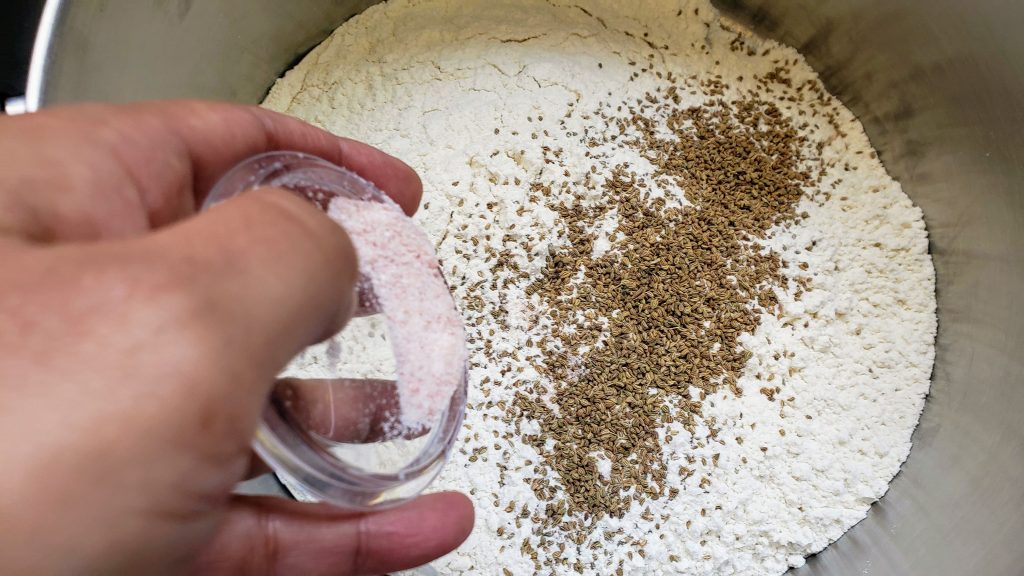
Adding salt and carom seeds 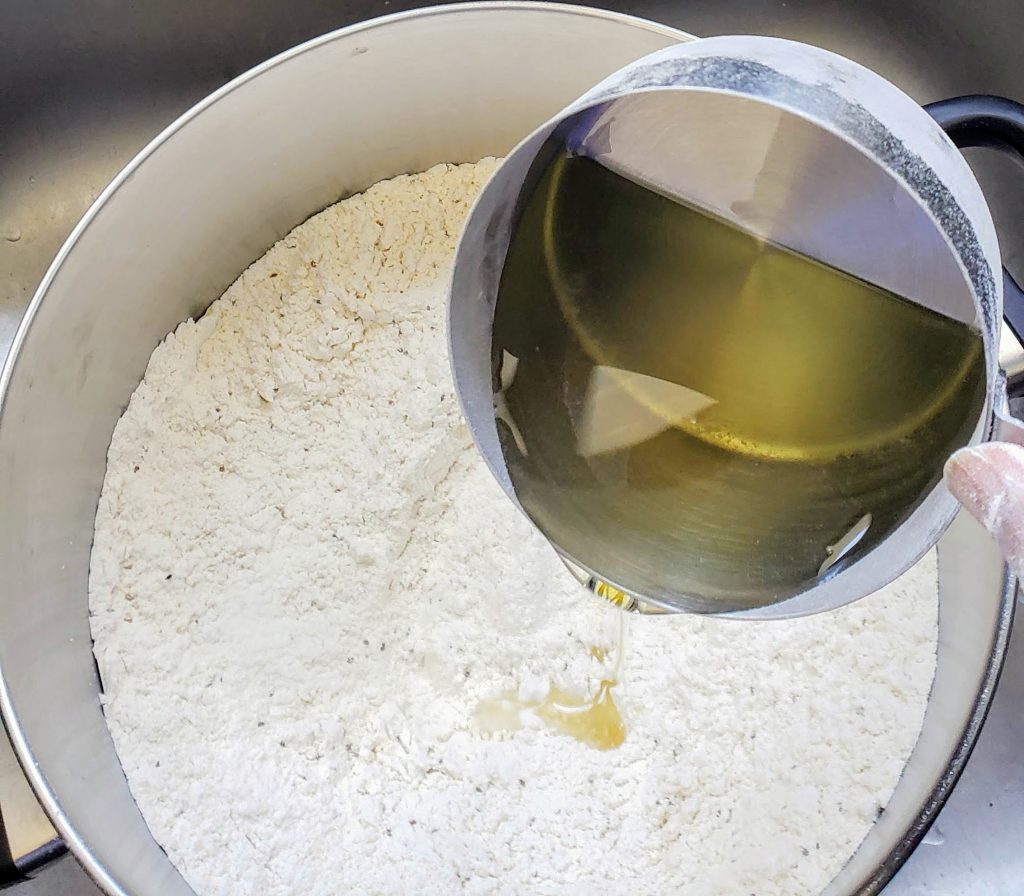
Adding canola oil 
dough must hold the shape of your fist easily
4. Slowly add the chilled water. Mix well, until the flour just barely comes together to form a ball of dough. Gather up any dry flour in the bowl and pat it into the formed dough ball. If needed, add another tablespoon or so of water until there is no remaining dry flour.
5. Wrap the ball of dough in cling wrap and let it rest at room temperature for 2 hours.
6. While the dough is resting, check the doneness of the potatoes by passing a sharp knife through the thickest part of the potato. There should be little to no resistance. Drain the potatoes and let them sit in cold water until they are cool enough to handle.
7. As your potatoes are cooling, wash and cut the hot peppers if you are using them. Line up the spices. Coarsely grind the coriander seeds in a mortar and pestle or under a rolling pin.
8. Heat a large non-stick skillet and add a few tablespoons of cooking oil. Add the cumin seeds (jeera). After a minute, the jeera will sizzle and give off a nutty aroma. Add the coarsely ground coriander seeds (sooka dhania) and the fennel.

Crushed coriander and whole fennel 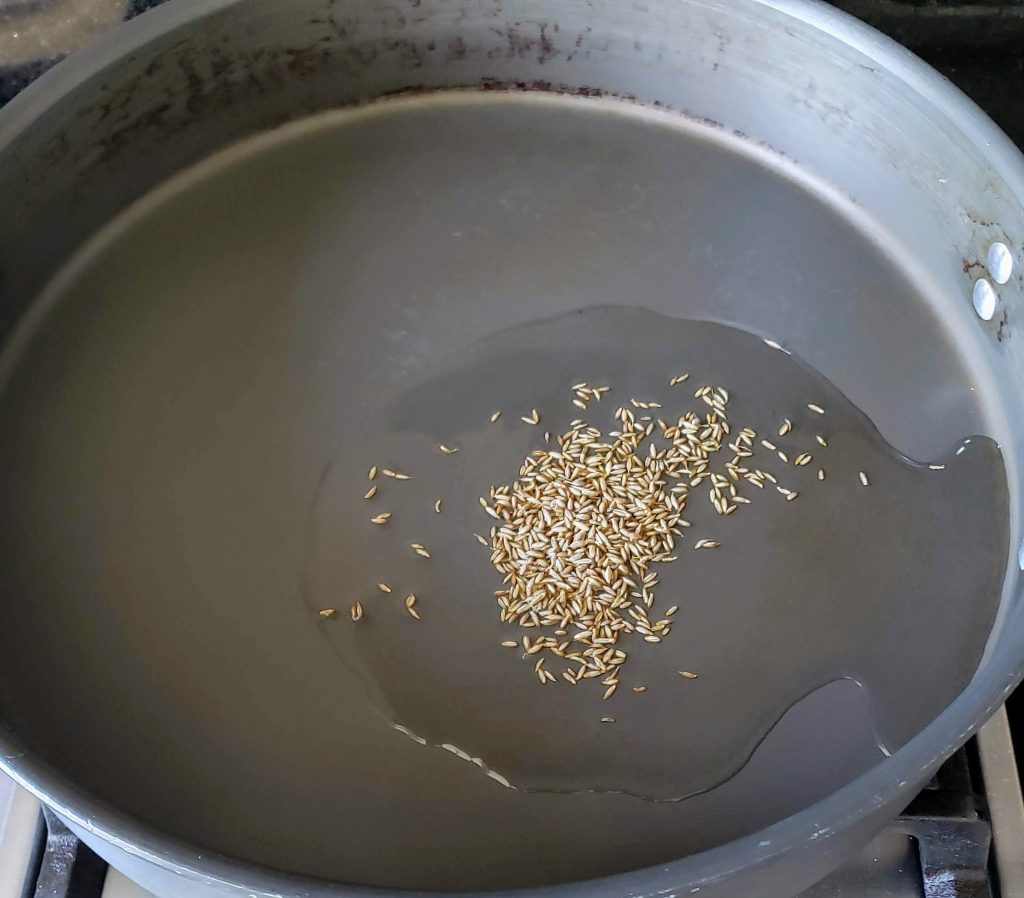
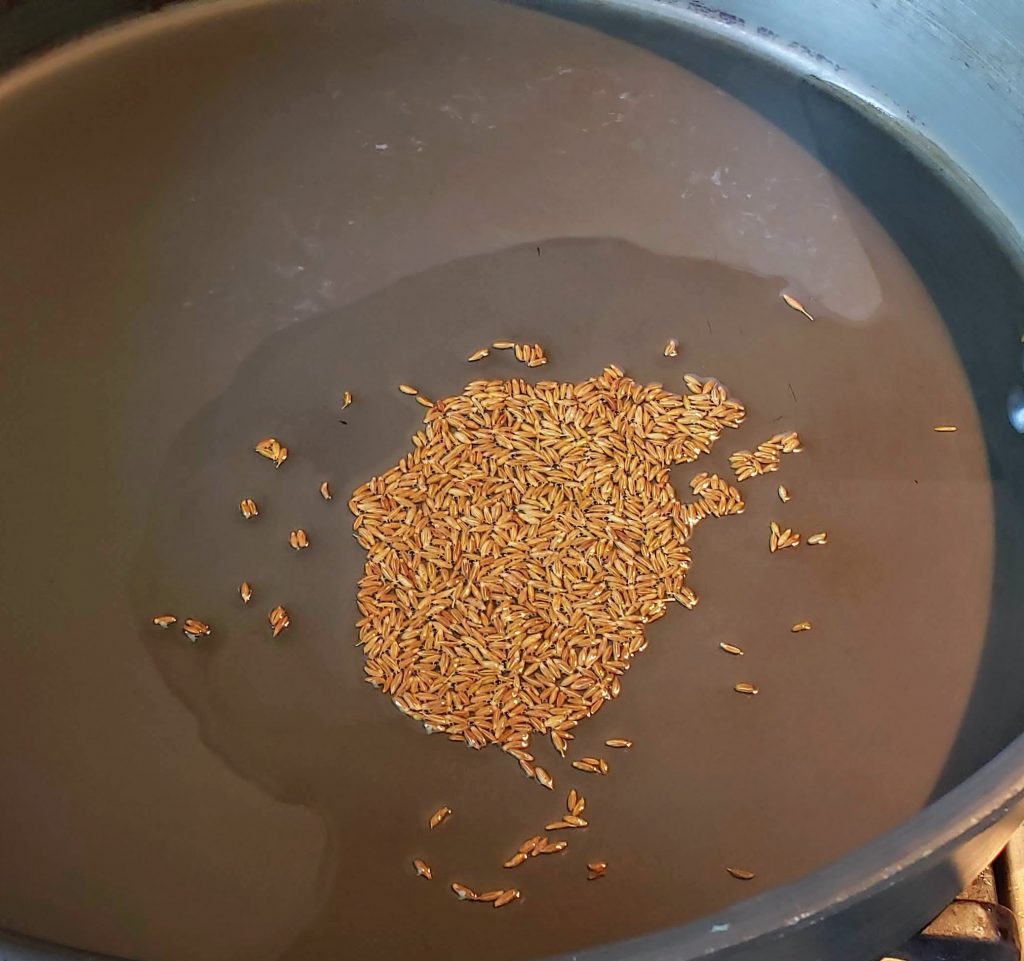
cumin toasted in oil 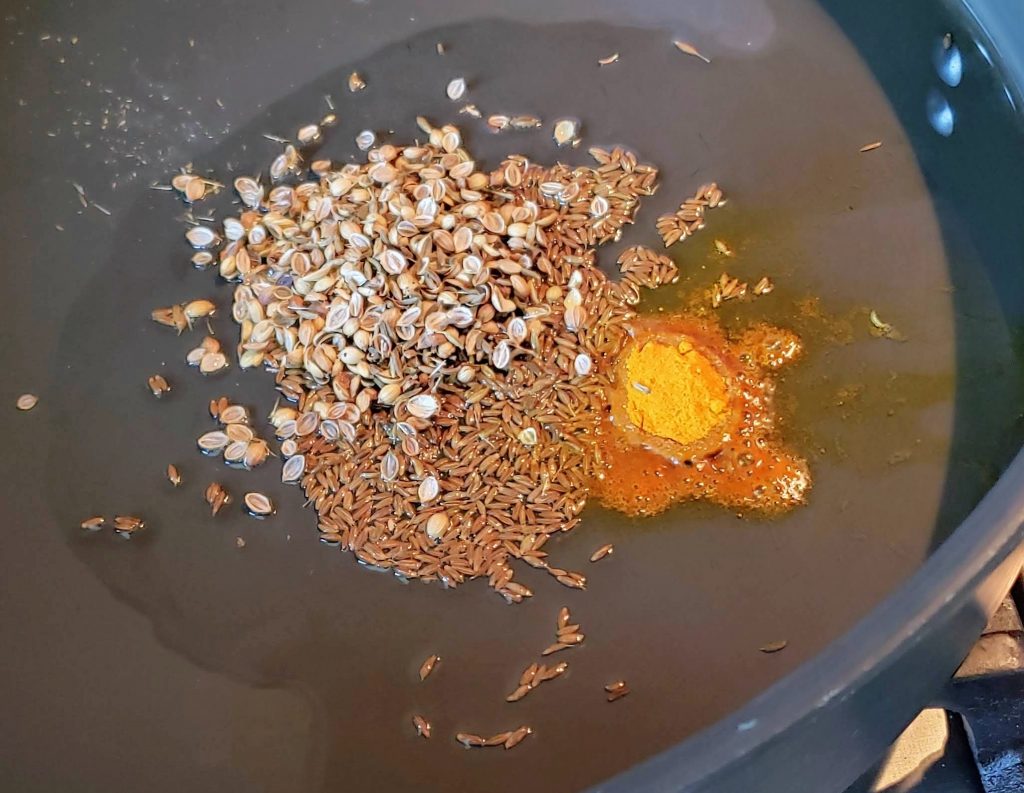
coriander, fennel, cumin and turmeric
9. Cook the spices for another 30 seconds and add the turmeric powder and the hot pepper either in its fresh or powdered form.
10. Add the peas and let them cook for two or three minutes. Turn off the burner until you have completed the next step. I can handle hot foods easily and was able to complete the next step while executing the previous steps.
11. Peel and grate the potatoes. Grating potatoes ensures lump-free mashed potatoes and does not require any specialized tools that take up space in the kitchen.
12. Over medium heat, add the grated potatoes to the skillet. Don’t worry if the potatoes are not completely cooked through since they will continue to cook in this step. Mix well.

grated potatoes 
hot pepper and spices 
green peas 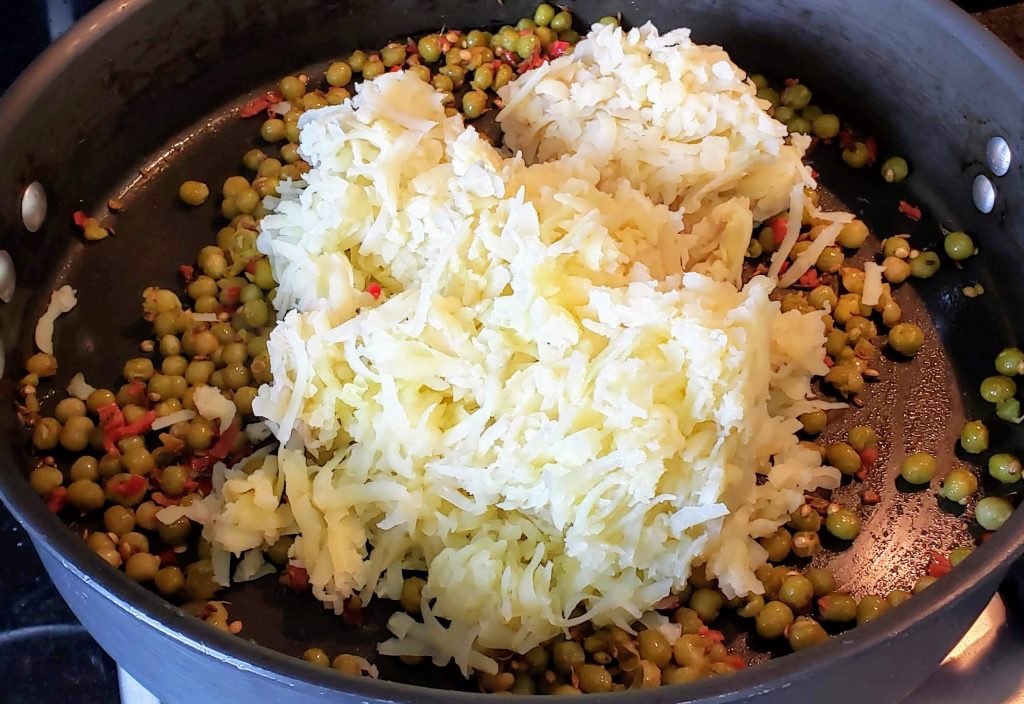
13. After 4 minutes, add the powdered spices (cumin powder, anardana powder, and amchur powder and black pepper). Mix well to distribute them evenly. Turn off the heat.
14. If the potatoes start to coat the bottom of the pan, they will come up as the mixture begins to cool.
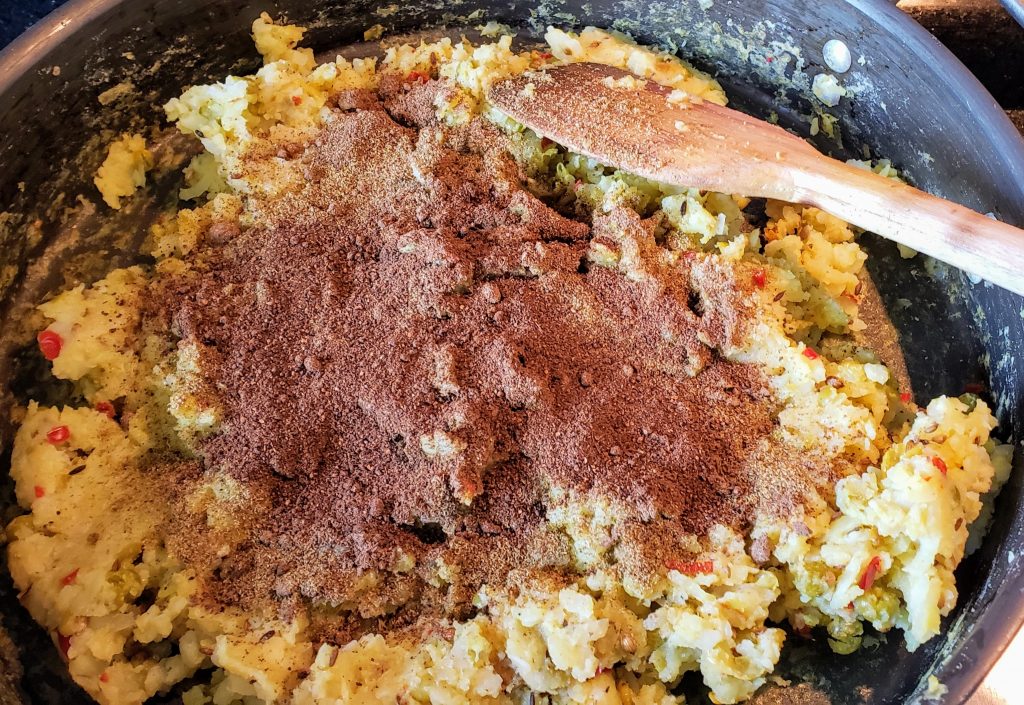
addition of the powdered 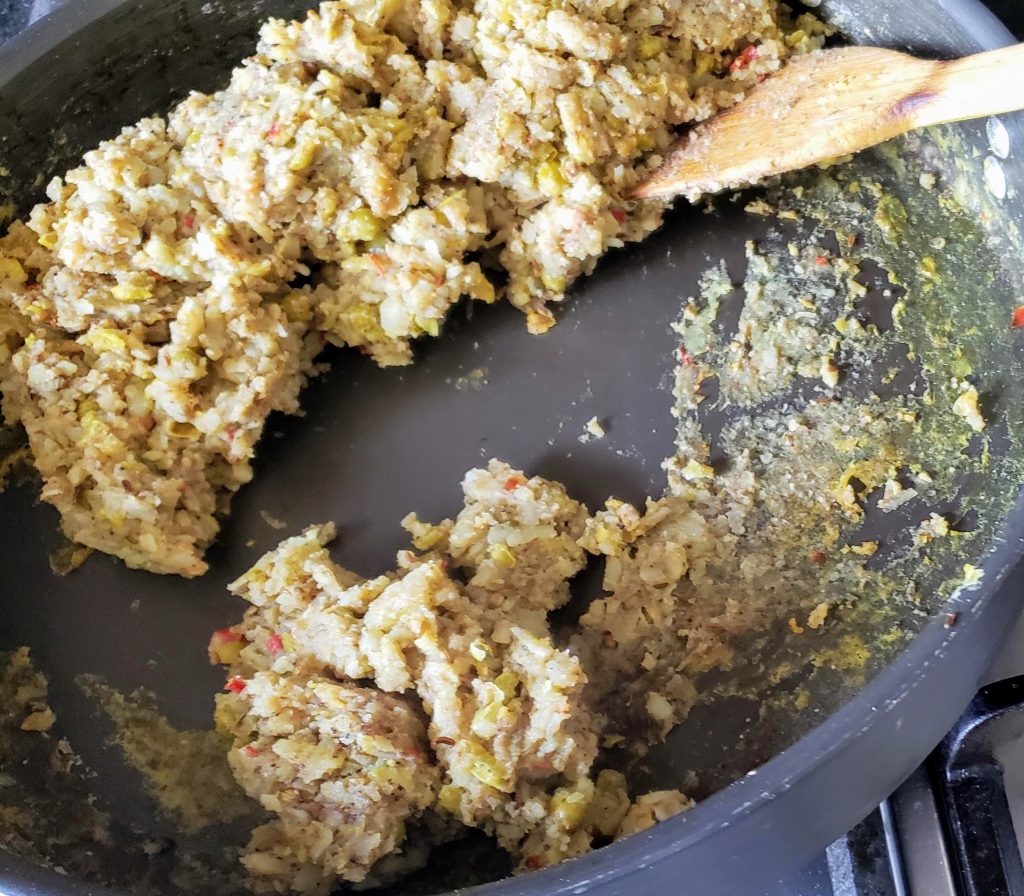
potatoes will release when they cool
15. Be sure to read the tips for deep frying and set up your equipment accordingly. Fill the vessel you are using for deep frying with either canola, peanut or sunflower oil to a depth of 2 1/2 inches. I would not use ghee as it is expensive and best used for frying desserts or cooking.
16. Heat over medium-high until the temperature of the oil reaches 350F. I would suggest using a thermometer designed for deep-frying. Otherwise, break off a small piece of dough, drop it into the oil and see if it bubbles up to the surface.
17. Fill a small dish with water and keep it nearby.
18. Meanwhile, break off a golfball-sized piece of dough and roll it out into an 8-inch circle without the addition of flour. I like my samosa pastry to be a paper-thin at about 1/16 of an inch.

golfball size dough 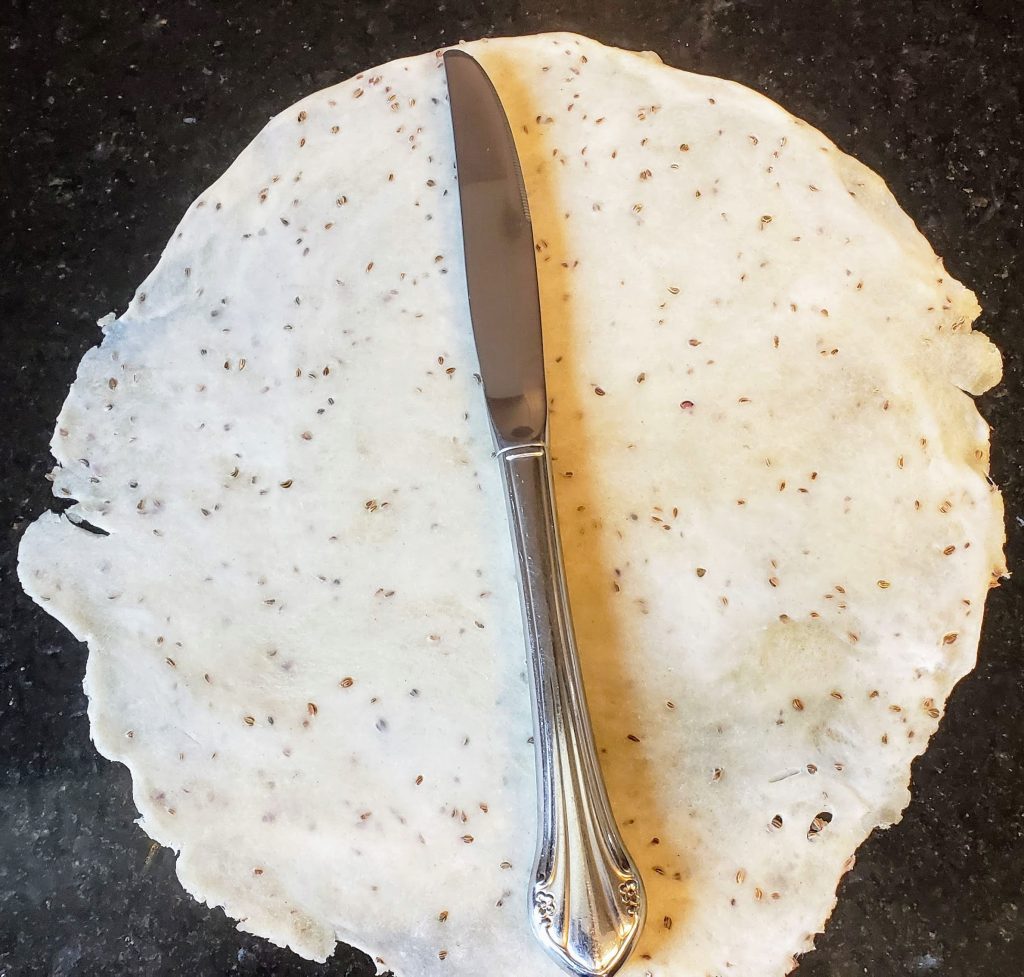
8-inch diameter circle 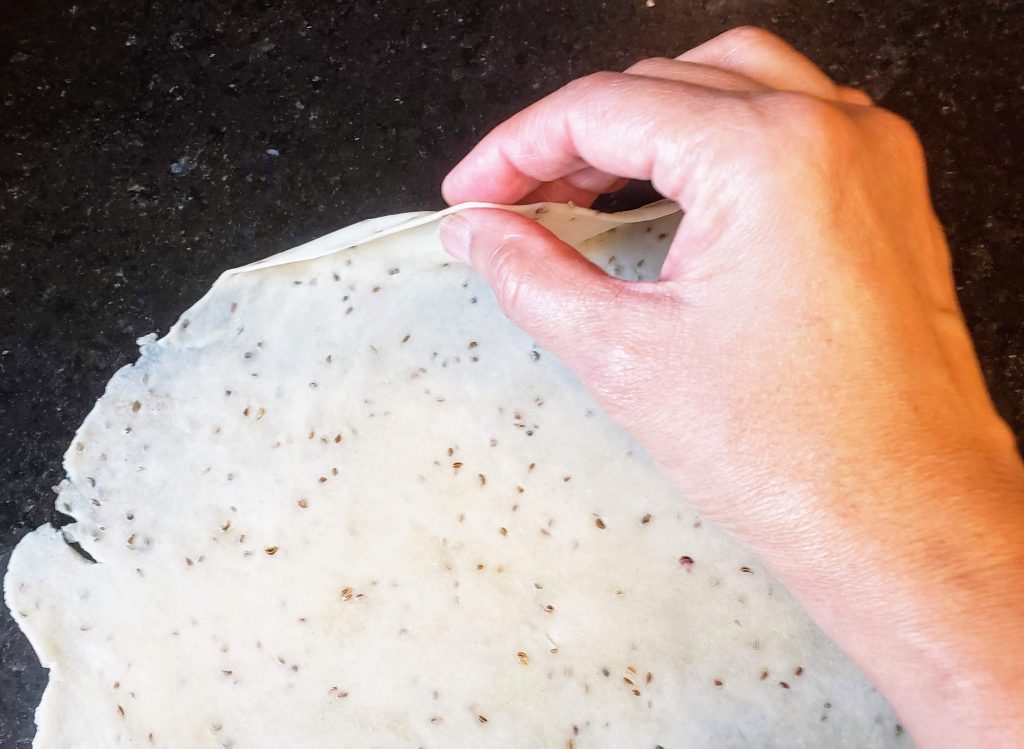
1/16-inch thick
19. Cut the circle into half using a table knife. working with one half of the pastry at a time, fold the corner of the semi-circle toward the middle.
20. Wet the tip of your index finger with the water and gently wet the folded over edge of the semi-circle of dough. The water will help you seal the diameter of the semi-circle into a cone. See the diagram. Make sure the tip of the cone and the edges are well-sealed.

cut the dough in half 
wet the edge 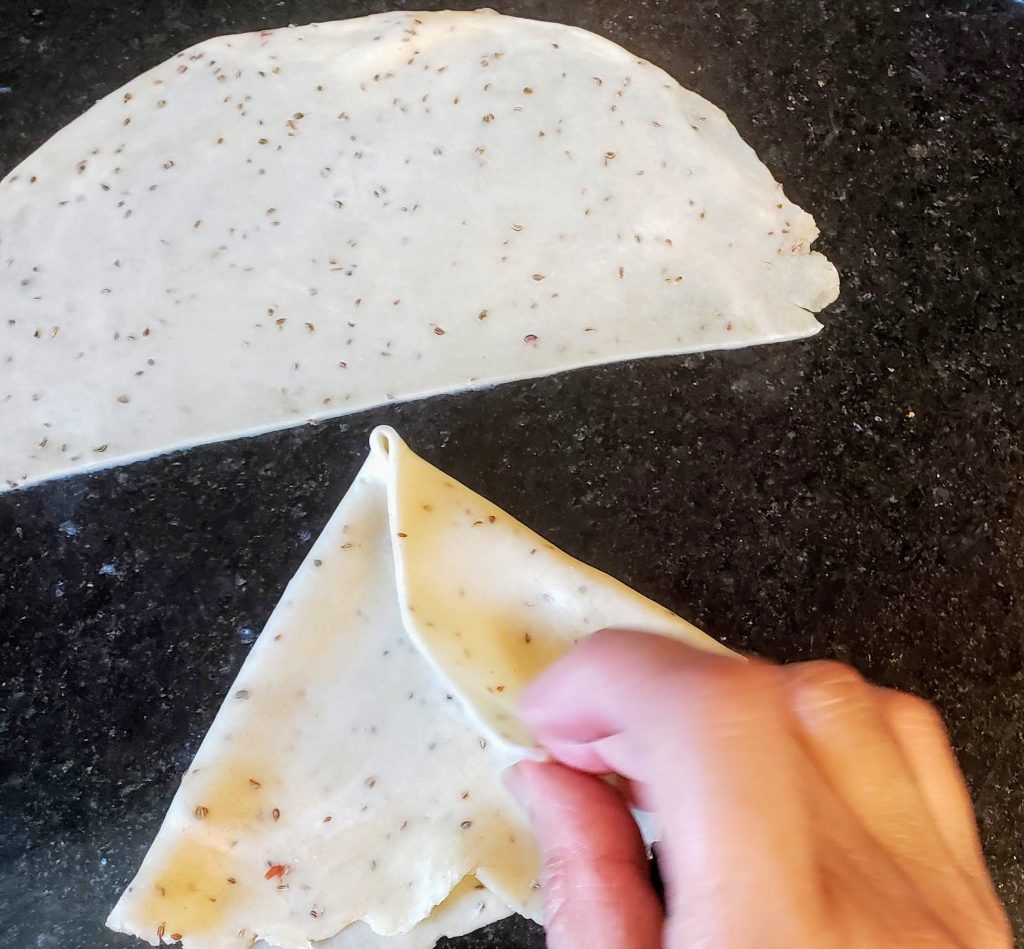
fold the other side over 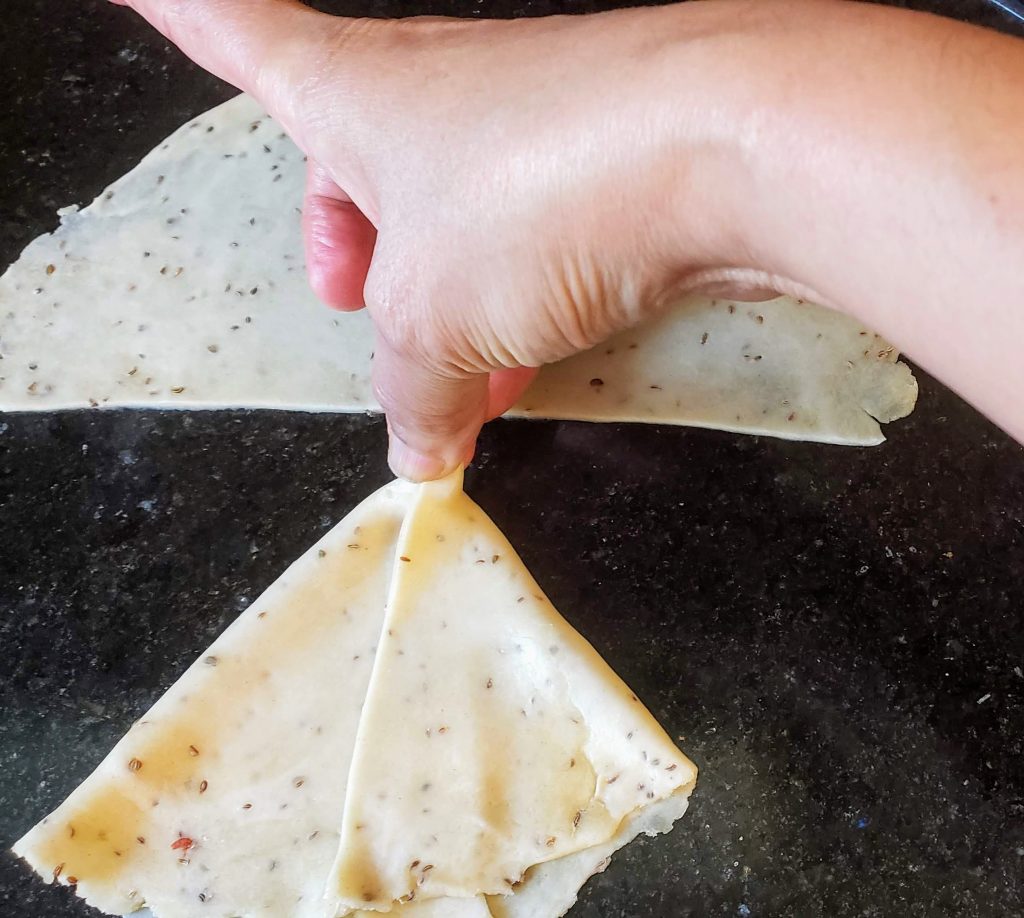
pinch the tip and seal the dough 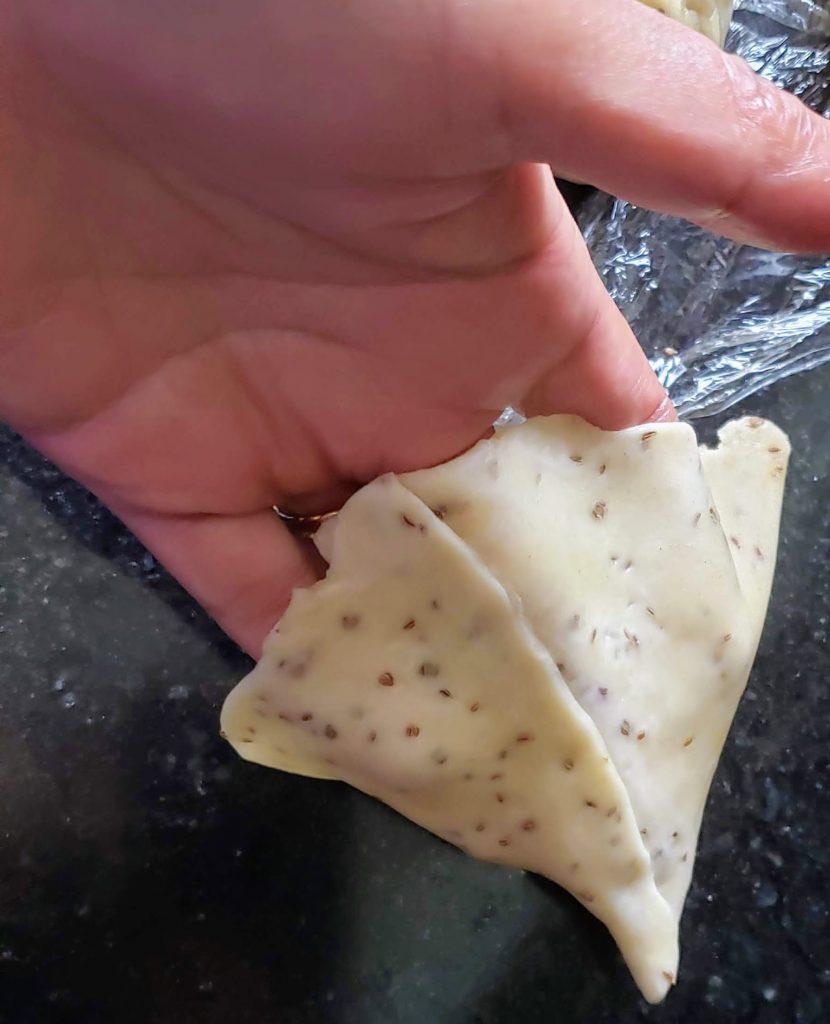
well-sealed edge
21. If you are right-handed, hold the cone of dough in your left hand with the mouth of the cone open. Add about 4 tablespoons of potato filling leaving a half-inch rim at the top. Do not overfill.
22. Wet the inside edge of the rim using your index finger and pinch the edges to seal. I pleat the rim as a form of decoration and to ensure that it will not open when I deep fry the samosa. Each circle of dough will yield two large samosas.
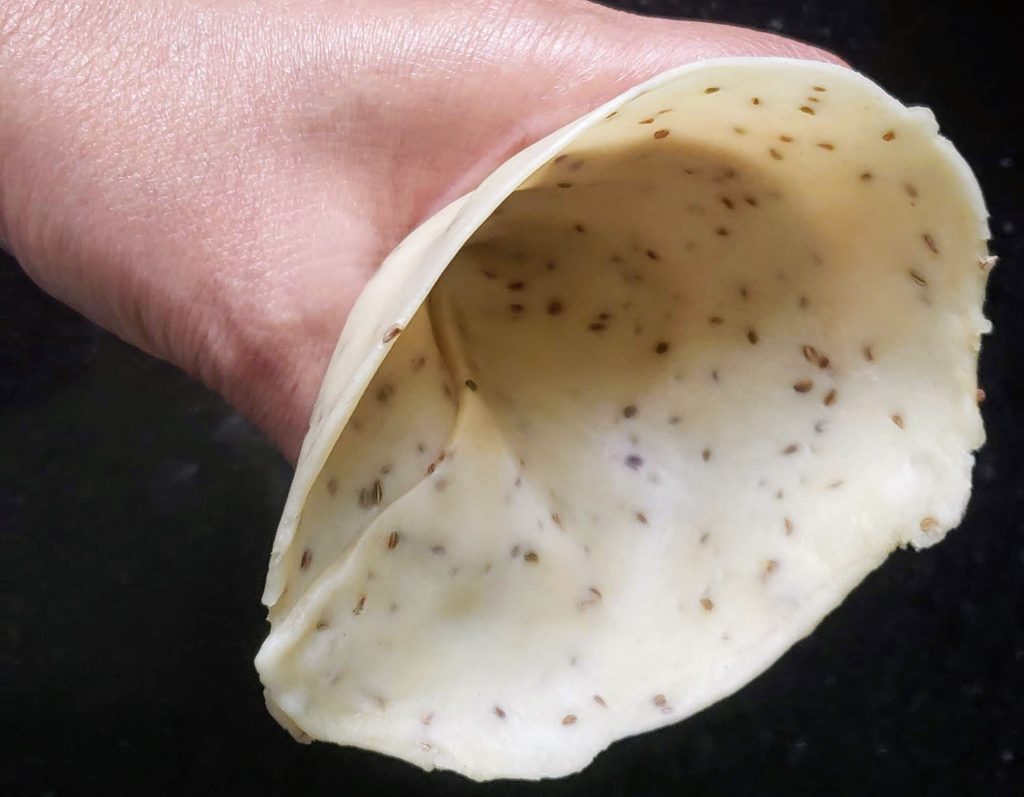
hold the cone to fill 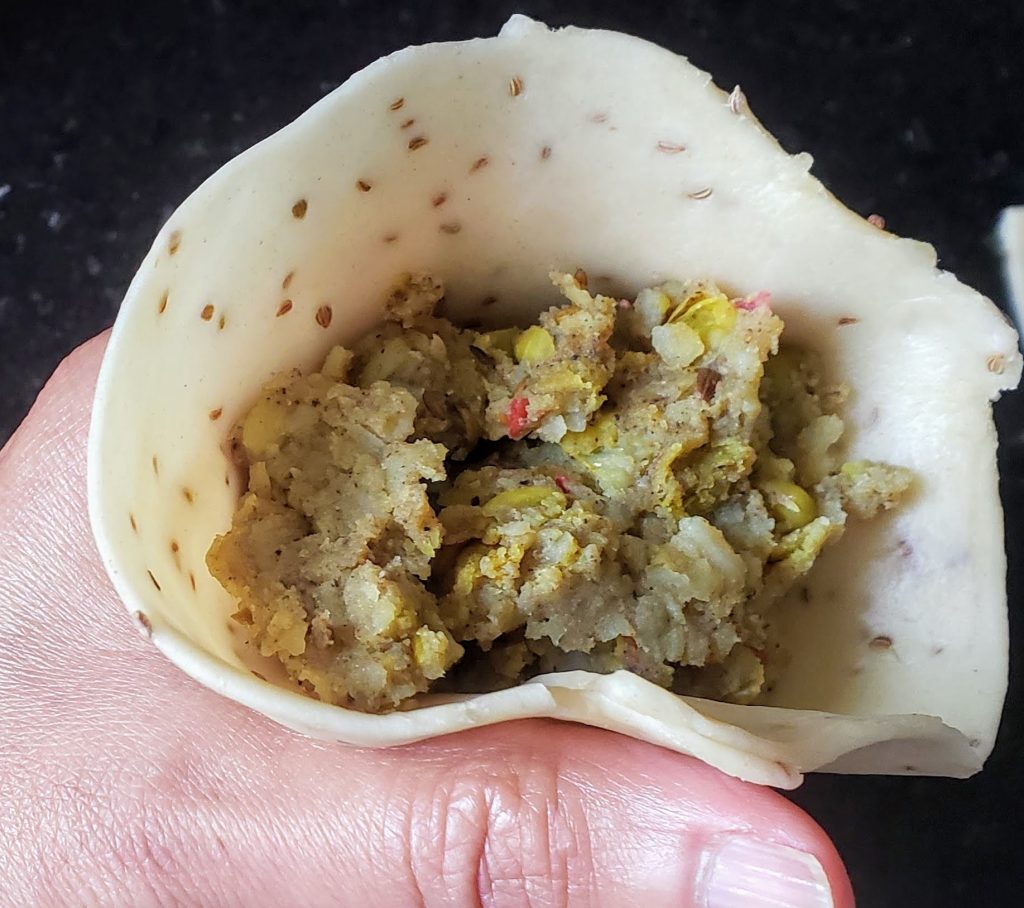
add 2 tablespoons of filling 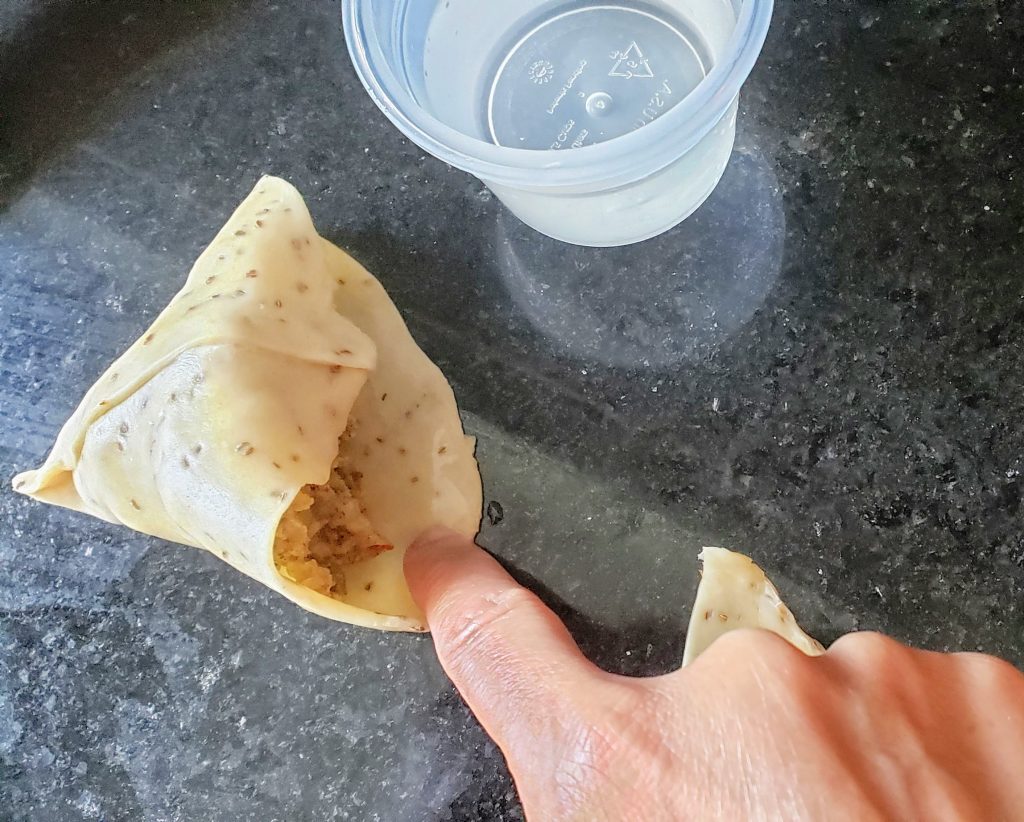
wet the rim 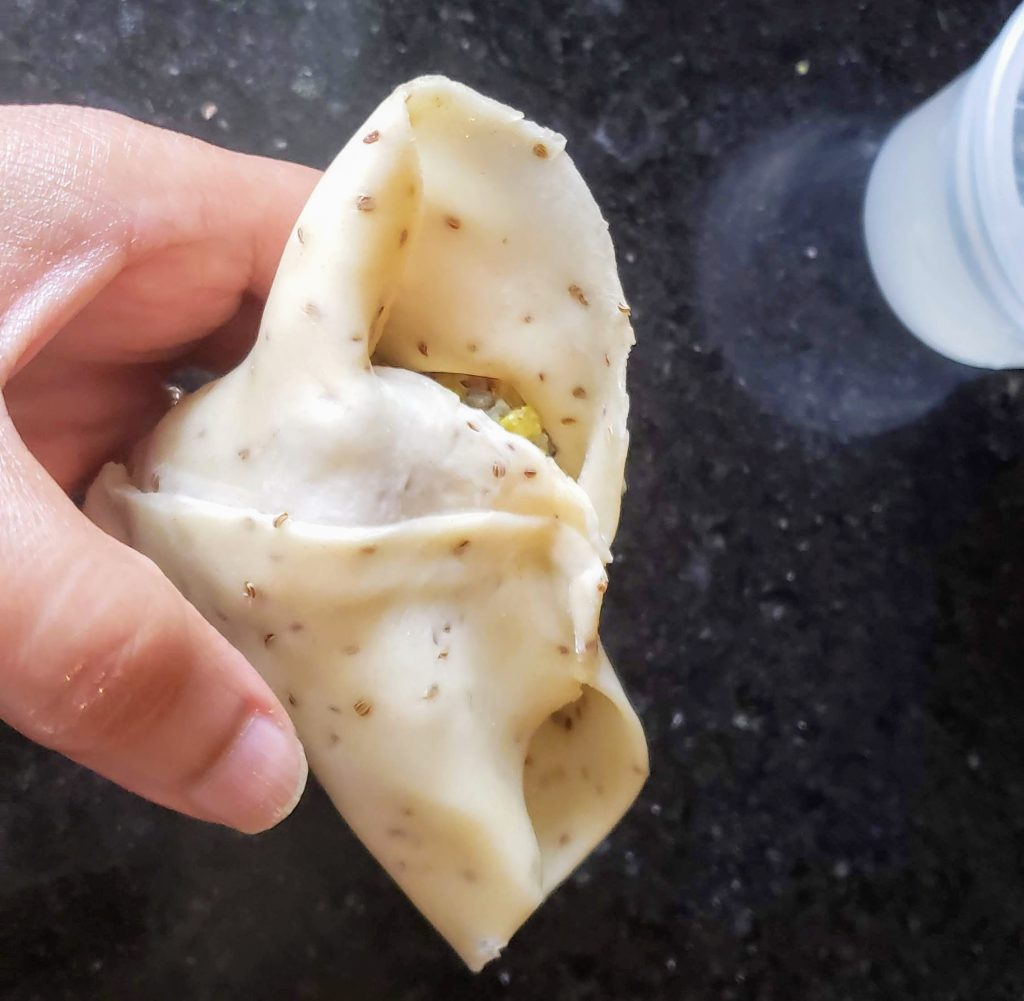
seal the rim 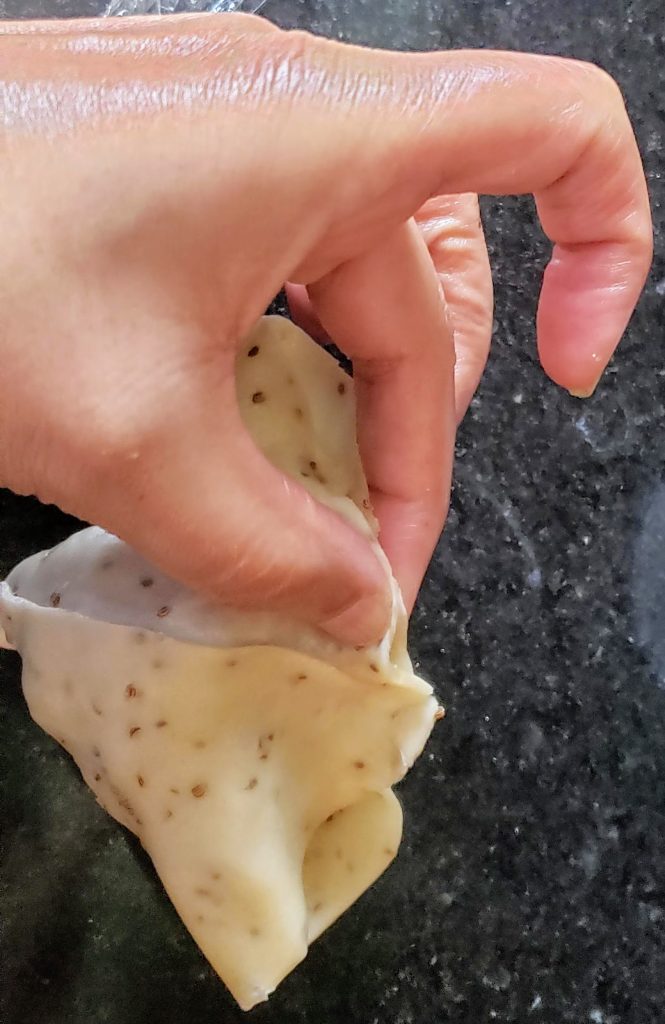
pinch to seal 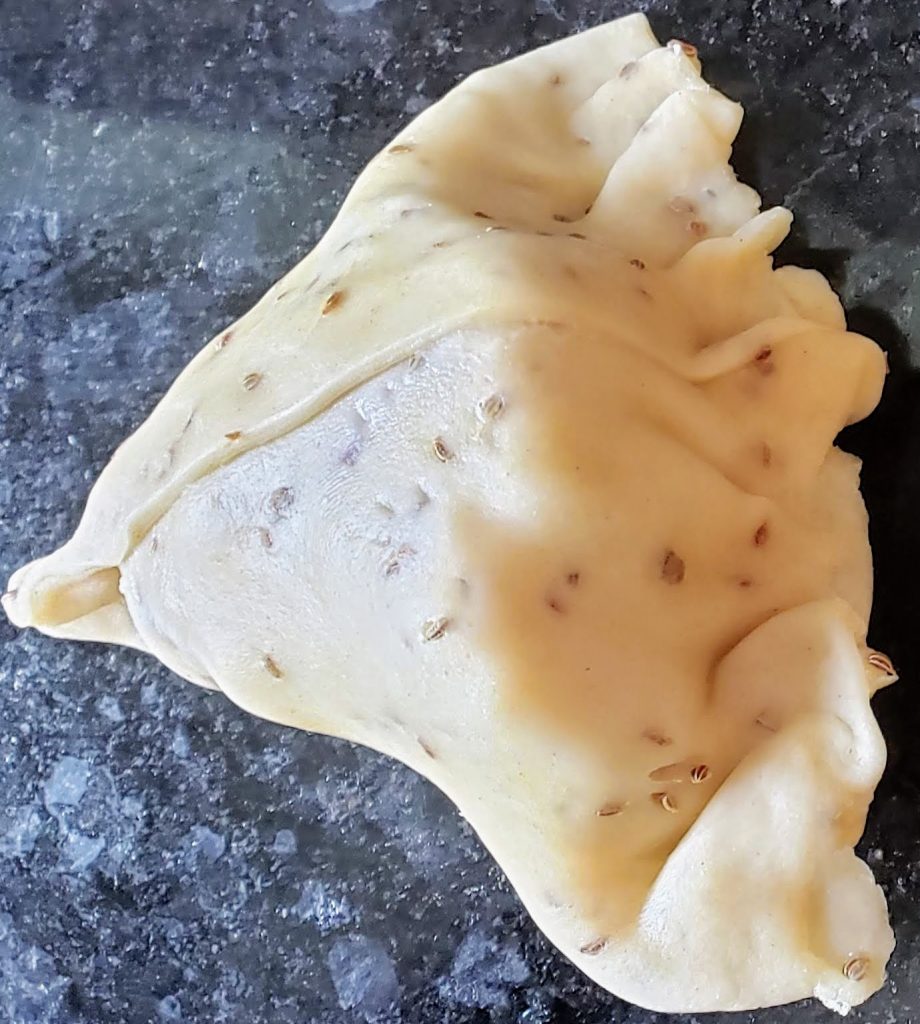
pleat the edges
23. Fry the first batch of Samosas, a few at a time, for about 1-2 minutes. Turn them over and cook for another minute. Remove from the oil and place on a paper towel-lined tray. Mop up the surface of the Samosas to absorb any excess oil before it gets reabsorbed into the food. Remember, the filling is completely cooked, you are only cooking the thin pastry which takes very little time. The Samosas will appear light in color.

fry a little at a time 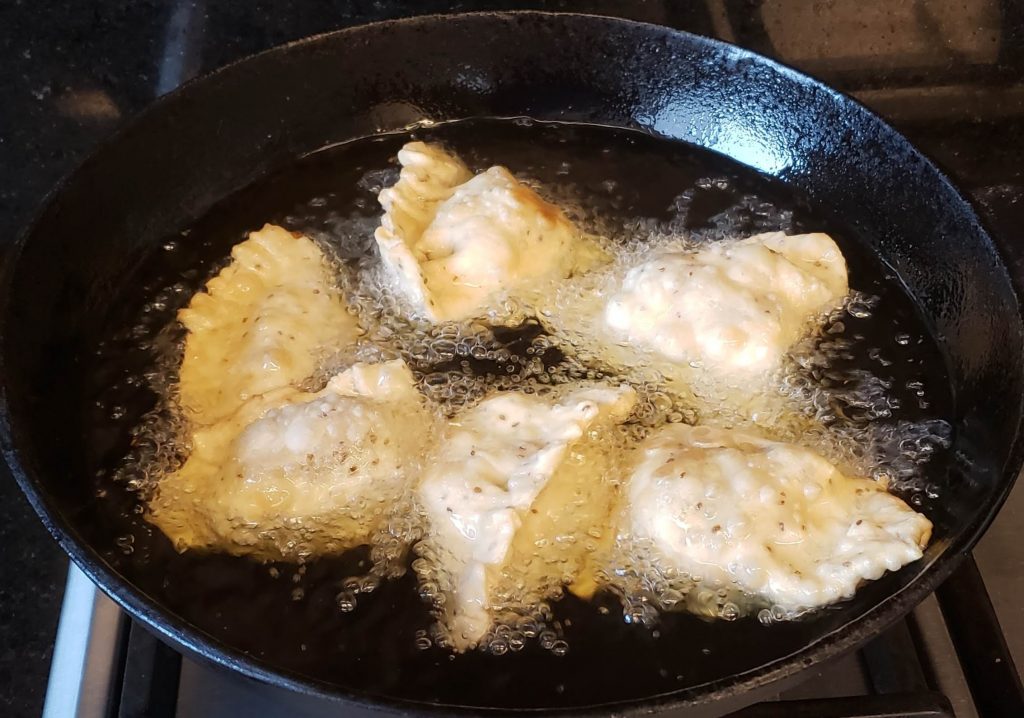
flip over 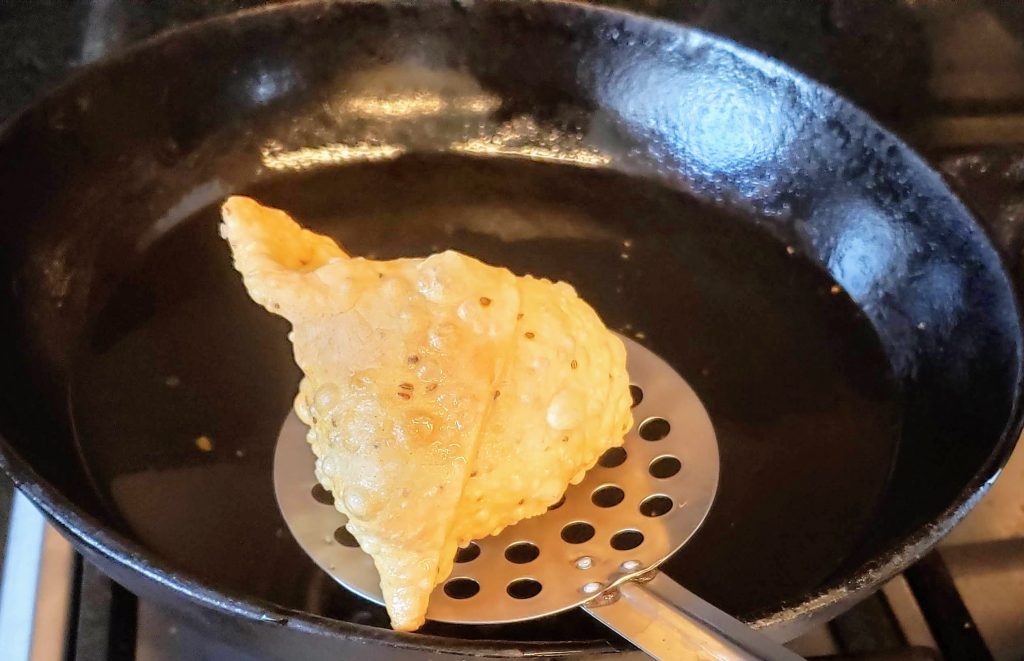
remove while still light in color, but no longer raw
24. Repeat Steps 18-23 until you have run out of either the filling or the dough. After the entire batch has been fried at 350F, allow the oil to heat up to 375F and refry the Samosas until they turn golden brown. This will take between 1 to 2 minutes per batch. Drain on a paper towel-lined tray and gently mop up the surface with paper towels before serving.

second frying 
golden brown 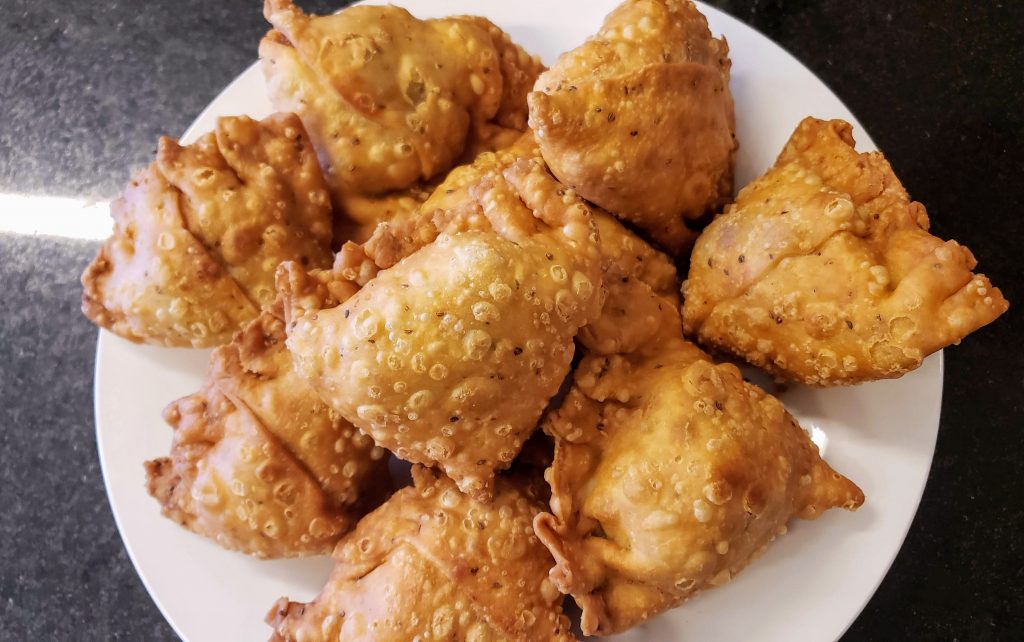
serve warm
25. Serve with tamarind chutney and mint/coriander chutney. Click on the links to get the recipes.
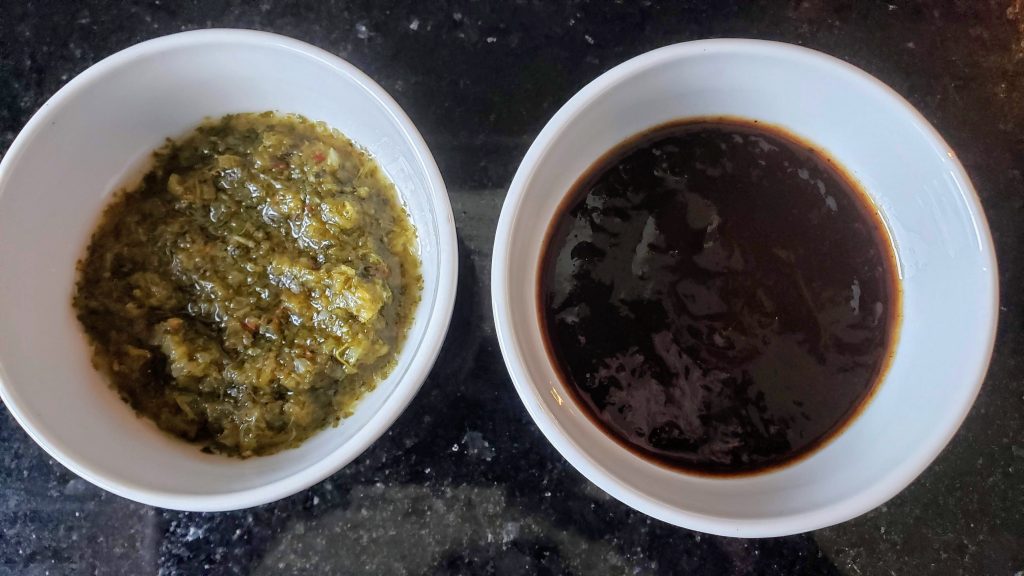
Mint/coriander chutney on left tamarind chutney on the right
Aside: Should you wish to serve the samosas on a different day, fry the entire batch once and let it cool to room temperature. Freeze the samosas in freezer bags or heavy-duty aluminum foil.
When you are ready to serve them, defrost for 15 minutes at room temperature and either refry them or bake them in the oven at 350F until golden brown.
Any remaining dough can be converted immediately to Mathis or frozen to be used later when making Kachoris or Samosas. The recipes will follow in another blog.
Any remaining filling can be used to make either Bread rolls, Tikis, or Parathas. Recipes for these will follow in other blogs.
Note *These ingredients may be purchased at your local Indian grocer. For this reason, I have given you the name of the spice both in English and Hindi as that is the name (written phonetically in the English alphabet) you will find it under when you go shopping.
Spices impart specific flavors and aromas that enhance the overall flavor of the dish when used correctly. Moreover, they have a lot of health benefits. The list below specifies:
- The name of the spice;
- The flavor(s) it imparts;
- How and when it may be used; and, finally,
- It’s health benefits.
Ajwain (carom seeds) – Astringent, sharp. Add last to season cooking oil as it is very strong and may turn bitter. It is used in making Kari (a stew made from gram flour) and added to lentil batters as it helps combat gas and bloating. Generally used in doughs or made into decoctions with a little salt for gas pain. Chew 1/2 a teaspoon of the seeds with 1/8 teaspoon of salt to get instant relief from acidity and/or gas pain. Good for indigestion and reducing gas. A decoction of the seeds is ingested with the addition of a little salt as a digestive aid. It is an anti-inflammatory. Carom is also an anti-oxidant and has anti-bacterial and anti-fungal properties. It is also high in iron.
Jeera/Geera (cumin seeds) – Earthy, smoky. The whole form is added as one of the first spices when seasoning cooking oil. If using it in the powdered form to season cooked food, add it after the burner has been turned off. Used whole when flavoring cooking oil in vegetarian and meat dishes. The whole form is added as one of the first spices when seasoning cooking oil. Used as a powder either by itself or as part of Garam Masala after cooking for both vegetarian and meat dishes. Whole seeds are boiled in water to make a tisane to aid digestion (reduces gas), for weight loss, and relaxation. Rich in iron – it has 66g of iron per 100g which is five times the daily dose. Aids in digestion; improves blood cholesterol; promotes weight loss and fat reduction; and, helps promote sleep. It also helps with diabetes. It has both stimulating and calming effects. Improves cognitive function and helps prevent cognitive disorders such as dementia and Alzheimers. It also improves lactation.
Amchur Powder (green mango powder) – Sour, slightly sweet, fruity. Used only in its powdered form. It is added to cooked food after turning the burner off. It is a large component in Chaat Masala, a condiment, sprinkled over Indian savory snacks like Papadi Chaat, Fruit and Potato Chaat, bean salads, etc.. It is used alone to impart a bright note to bland vegetarian dishes such as Lotus root, boiled black chickpeas, squash, potato, and yam dishes. Added to ground meat curry (Keema) to add a bright, sour note. Added to vegetable stuffing for Parathas (Indian stuffed flatbreads). Boosts digestion, contains vitamins A, C, D, and B6 which help your immune system. Amchur is also an antioxidant. It stimulates detoxification; helps in weight loss; and, is good for the heart.
Saunf (fennel seeds) – Licorice-like taste, slightly sweet. It is added in its whole form to the cooking oil in the middle of the seasoning process. Used either whole or roasted and ground in vegetable stuffings for Indian savory snacks like Kachoris or Samosas. Chewed whole (with or without sugar) to help freshen breath; aid in digestion; and, combat acidity after a meal. Fennel seeds are often boiled to make a flavored tisane (similar to Jeera/Cumin). Fennel is used ground or whole in Chai Masala (Tea flavoring). Helps detoxify the body; purifies the blood; controls heart rate and blood pressure; and, is rich in potassium.
Sooka Dhania (coriander seeds) – Smoky (if left whole) and sour (if ground). It is added in its split form to the cooking oil in the middle of the seasoning process. If using it in the powdered form to season cooked food, add it after the burner has been turned off. Used in powder form to season vegetable stuffings when making flatbreads (Parathas) or savory pastries (Samosas and Kachoris). Used roasted and coarsely ground to season cooking oil in vegetarian and meat gravies. Ground into a powder and used at the end to layer flavor in both vegetarian and meat dishes. Is one of the components of Garam Masala. Whole seeds are boiled into a tisane to relieve menstrual cramps during heavy flow. High in fiber and aids in bowel movement; promotes insulin production. Rich in copper, zinc, and iron and vitamins K, C, and B which are good for healthy skin and hair. Assists in weight loss and reduces body fat. FYI, plant coriander seeds to get fresh coriander plant.
Dried Pomegranate seeds (anardana) – Sour, fruity. If using it in the powdered form to season cooked food, add it after the burner has been turned off. Used whole or in powder form to season vegetable stuffings when making flatbreads (Parathas) or savory pastries (Samosas and Kachoris). Used to season boiled, dry bean dishes (kale chole) and potato and vegetable cutlets (Tikis). Made into candy and eaten. Natural aphrodisiac; lowers blood pressure; improves heart health; and, improves memory. Contains punicic acid, an Omega-5 fatty acid that helps fight breast cancer.
Haldi (turmeric powder) – Bitter and earthy.Turmeric is added to the oil after all the other spices during the cooking process. Used in powder form or the fresh, grated or minced form to season vegetable and meat dishes. Made into a pickle and eaten fresh. Boiled using fresh minced or powdered into a Tisane. Powdered form mixed with yogurt and black pepper and consumed. Added in powdered form to milk and consumed to combat sickness like cold/flu/throat ache or help reduce swelling in the body. Mixed with oil (coconut or any neutral tasting oil) into a paste as a wound dressing to prevent infection and reduce swelling; or, rubbed onto the face as a skin cleanser. The main active ingredient is curcumin. CURCUMIN IS POORLY ABSORBED BY THE BODY AND MUST BE CONSUMED WITH BLACK PEPPER TO INCREASE ITS ABSORPTION BY 2000%. If you are using a turmeric supplement, make sure it contains piperine (BioPerine) to help with curcumin absorption, otherwise, the curcumin will just pass through your body and not be absorbed. Curcumin is fat-soluble, so it is good to eat turmeric with a fatty meal. Curcumin is a powerful anti-inflammatory and anti-oxidant. Fights Alzheimer’s and depression by increasing a growth hormone (BDNF) that increases the growth of new neurons. Helps minimize the risk of heart disease. Helps fight cancer.
Kali Mirch (black pepper) – Sharp, spicy. Whole peppercorns can be added early on when using them to season cooking oil. However, the ground form is only used toward the end of cooking. Black pepper is used as a condiment and a food preservative. It is one of the components of Garam Masala and Chaat Masala. It is used whole to season doughs like Mathi (savory crip wafer). It is most often ground and used as a condiment in cooked foods. The ground form, when mixed with honey is used to relieve coughs and sore throats and improve breathing. Whole peppercorns are brewed into a tisane to effect the same benefits. For best results, don’t buy it preground as you’ll lose not only flavor but also many health benefits. BLACK PEPPER INCREASES THE BIOAVAILABILITY of certain other nutrients, especially, but not limited to CURCUMIN, WHICH IS THE ACTIVE INGREDIENT OF TURMERIC. It helps reduce swelling; is a known antibacterial; it’s an anti-inflammatory; and, is high in antioxidants. It is a natural pain killer. In ancient times, it was used in conjunction with salt to preserve meat. It helps drain the sinuses.
Cayenne pepper – Spicy, sharp.Added directly after the dried whole spices either in its fresh or powdered form. When using its whole, dried form add it in the middle when seasoning the oil. Minced and mixed in Chaat and bean salads or used whole, as a condiment or in a mixed vegetable salad. Hot peppers are often eaten as pickles. Powdered, whole dried, or fresh minced chili peppers are used in cooking and added directly after the dried spices to season the cooking oil. Hot peppers have anti-bacterial; anti-fungal; anti-inflammatory; and, anti-oxidant properties. Helps fight the cold/flu; reduces joint pain; improves metabolism; promotes weight loss; and, are rich in vitamins A, B6, C, K1, and minerals like potassium and copper.
Written by Anju Kapur of Anju’s Table. All content and images on this site are copyright protected. Please do not use any of my images without my permission. Should you wish to share this recipe on your site, please add a link to this post as the source.
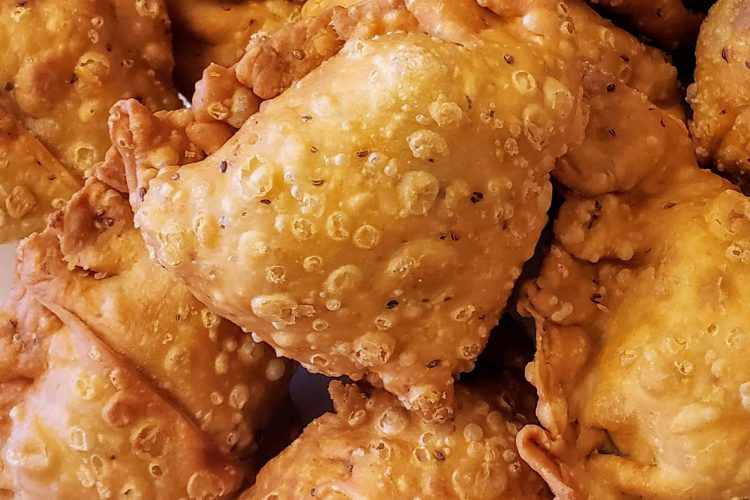
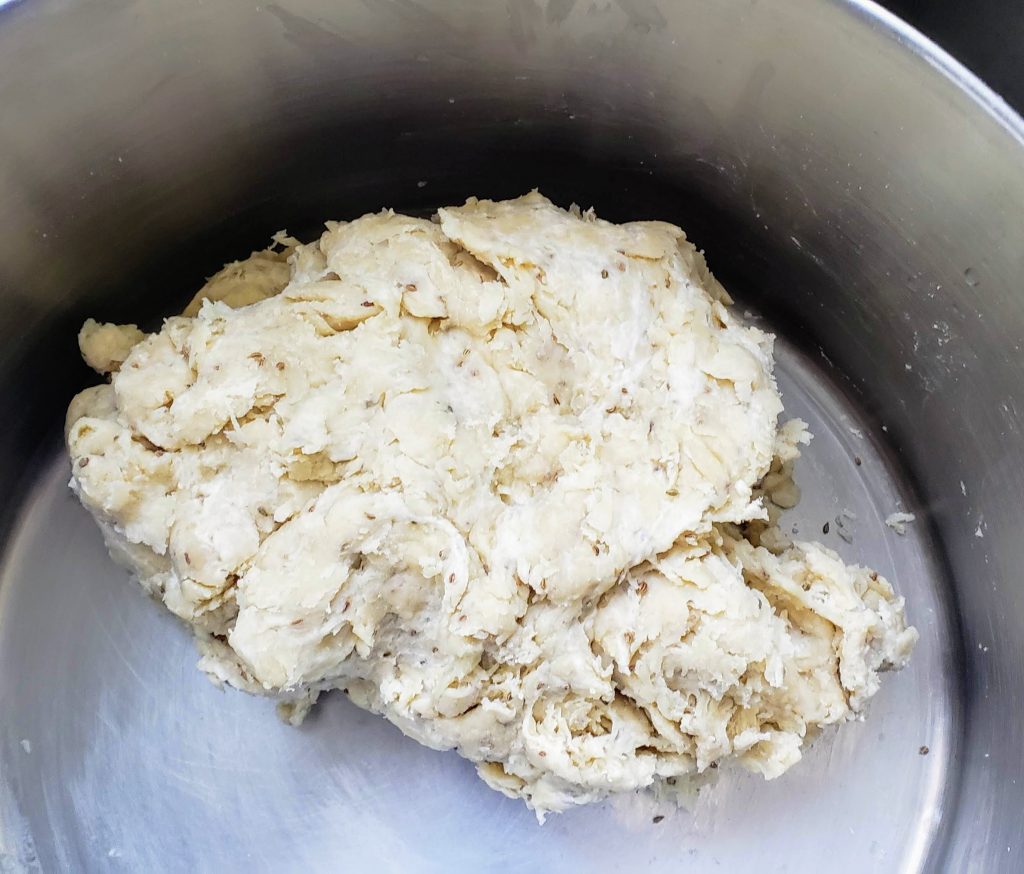
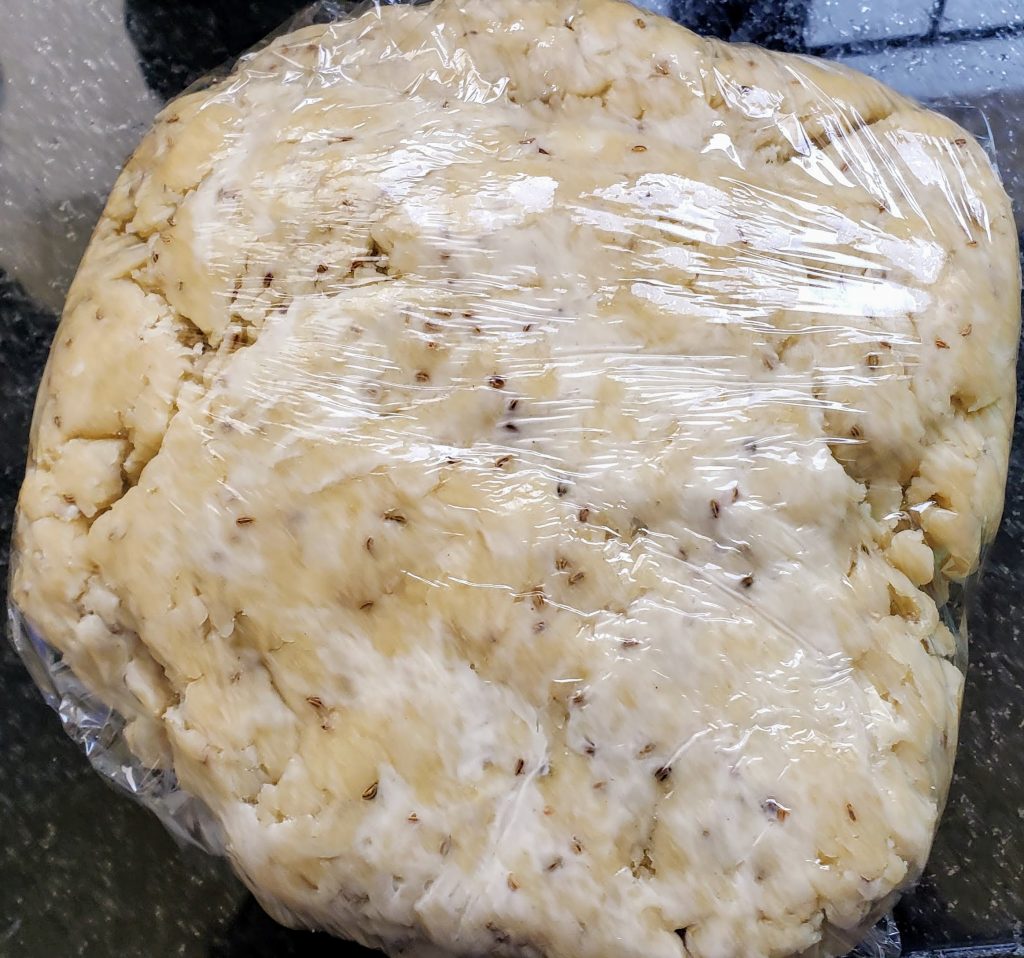
[…] chutney is used as a relish during a meal, a condiment alongside pakodas (savory fritters) and samosas, a filling for Indian high tea finger sandwiches or as one of the sauces used in making Behl Puri […]